List of apex predators
This is a partial list of apex predators—those predators that are not preyed upon as healthy adults in the wild. Full scavengers (e.g. most vultures), although they may not be preyed on either, are not counted as apex predators unless they at least partially depend on capturing live prey. Many species listed here are only apex predators within certain environments, e.g. coyotes are only apex predators when larger predators such as the gray wolf or the brown bear are absent.
Extinct dinosaurs that were likely apex predators
Spanning several millennia, ages, epoch, and eras, these extinct carnivorous dinosaurs were likely apex predators based on their size and dietary needs. Some may have also been scavengers as well.

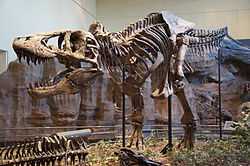

- Abelisaurus
- Achillobator
- Acrocanthosaurus
- Aerosteon
- Afrovenator
- Alectrosaurus
- Alioramus
- Allosaurus
- Albertosaurus
- Altispinax
- Alvarezsaurus
- Appalachiosaurus
- Aublysodon
- Aucasaurus
- Australovenator
- Austroraptor
- Bahariasaurus
- Balaur
- Bambiraptor
- Baryonyx
- Becklespinax
- Byronosaurus
- Carcharodontosaurus
- Carnotaurus
- Caseosaurus
- Ceratosaurus
- Chilantaisaurus
- Chindesaurus
- Coelophysis
- Coelurus
- Compsognathus
- Cristatusaurus
- Cryolophosaurus
- Daemonosaurus
- Dahalokely
- Daspletosaurus
- Deinodon
- Deinonychus
- Deltadromeus
- Dilong
- Dilophosaurus
- Dromaeosaurus
- Dryptosaurus
- Ekrixinatosaurus
- Elaphrosaurus
- Eocarcharia
- Eoraptor
- Eotyrannus
- Eustreptospondylus
- Fukuiraptor
- Gasosaurus
- Genyodectes
- Giganotosaurus
- Gorgosaurus
- Guanlong
- Haplocheirus
- Herrerasaurus
- Hesperonychus
- Iliosuchus
- Indosaurus
- Indosuchus
- Kryptops
- Labocania
- Liliensternus
- Linheraptor
- Lourinhanosaurus
- Lythronax
- Majungasaurus
- Mapusaurus
- Masiakasaurus
- Megalosaurus
- Megaraptor
- Metriacanthosaurus
- Microraptor
- Monolophosaurus
- Mononykus
- Nanotyrannus
- Nanuqsaurus
- Neovenator
- Orkoraptor
- Pamparaptor
- Patagonykus
- Poekilopleuron
- Pycnonemosaurus
- Pyroraptor
- Qianzhousaurus
- Rahonavis
- Rajasaurus
- Raptorex
- Rugops
- Sauroniops
- Saurophaganax
- Saurornithoides
- Saurornitholestes
- Shuvuuia
- Siamosaurus
- Siamotyrannus
- Siats
- Sinornithosaurus
- Sinocalliopteryx
- Sinraptor
- Spinosaurus
- Staurikosaurus
- Suchomimus
- Szechuanosaurus
- Tarascosaurus
- Tarbosaurus
- Tawa
- Teratophoneus
- Tianyuraptor
- Torvosaurus
- Troodon
- Tsaagan
- Tyrannosaurus
- Unenlagia
- Utahraptor
- Velociraptor
- Yangchuanosaurus
- Yutyrannus
- Zanabazar
- Zhuchengtyrannus
Other prehistoric apex predators
Terrestrial
- Agriotherium
- Amphicyon
- Andrewsarchus
- Archaeotherium
- Arctodus simus
- Arctotherium
- Bullockornis
- Canis dirus
- Cynotherium sardous
- Daeodon
- Dimetrodon
- Dinofelis
- Dromornis
- Eotitanosuchus
- Fasolasuchus
- Gastornis
- Gorgonops
- Homotherium
- Hyaenodon
- Inostrancevia
- Kelenken
- Madtsoia
- Megalania
- Megistotherium
- Miracinonyx
- Neanderthal
- Ornithosuchus
- Panthera onca gombagenzis
- Panthera leo atrox
- Panthera leo melanochaita
- Panthera leo spelaea
- Panthera tigris acutidens
- Phorusrhacos
- Postosuchus
- Proterogyrinus
- Saurosuchus
- Smilodon
- Thylacine
- Thylacoleo
- Thylacosmilus
- Titanis
- Titanoboa
- Ursus maritimus tyrannus
- Ursus spelaeus
Aerial
Aquatic
Extant predators
These living carnivores or omnivores are apex predators.
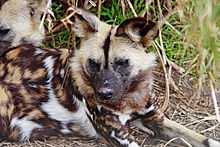
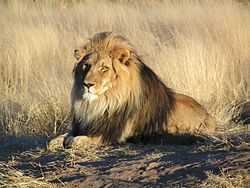
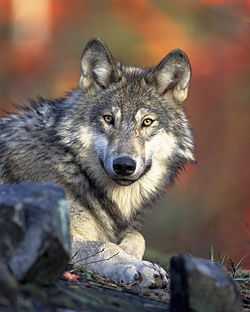


Terrestrial
- African wild dog - (Lycaon pictus)
- Amboina sail-finned lizard - (Hydrosaurus amboinensis)
- American badger - (Taxidea taxus)
- American black bear - (Ursus americanus)
- Asian Badger - (Meles leucurus)
- African golden cat - (Profelis aurata)
- Asian golden cat - (Pardofelis temminckii)
- Black-backed jackal - (Canis mesomelas)
- Black-headed bushmaster - (Lachesis melanocephala)
- Black-headed python - (Aspidites melanocephalus)
- Black mamba - (Dendroaspis polylepis)
- Blood python - (Python curtus)
- Bobcat - (Lynx rufus)
- Brown tree snake* - (Boiga irregularis)
- Canada lynx - (Lynx canadensis)
- Caracal - (Caracal caracal)
- Cat* - (Felis catus)
- Central American bushmaster - (Lachesis stenophrys)
- Cheetah - (Acinonyx jubatus)
- Chimpanzee - (Pan troglodytes)
- Clouded leopard - (Neofelis nebulosa)
- Common boa - (Boa constrictor)
- Cougar - (Puma concolor)
- Coyote - (Canis latrans)
- Crab-eating fox - (Cerdocyon thous)
- Crocodile monitor - (Varanus salvadorii)
- Culpeo* - (Lycalopex culpaeus)
- Diamond python - (Morelia spilota spilota)
- Eastern diamondback rattlesnake - (Crotalus adamanteus)
- Ethiopian wolf - (Canis simensis)
- European badger - (Meles meles)
- Eurasian lynx - (Lynx lynx)
- Fennec fox - (Vulpes zerda)
- Fishing Cat - (Prionailurus viverrinus)
- Fossa - (Cryptoprocta ferox)
- Gaboon viper - (Bitis gabonica)
- Golden jackal - (Canis aureus)
- Gray wolf - (Canis lupus)
- Eastern wolf - (Canis lycaon or Canis lupus lycaon)
- Himalayan wolf - (Canis himalayensis or Canis lupus himalayensis)
- Indian wolf - (Canis lupus pallipes)
- Dingo - (Canis lupus dingo)
- Dog - (Canis lupus familiaris)
- Brown bear - (Ursus arctos)
- Honey badger - (Mellivora capensis)
- Human - (Homo sapiens)
- Iberian lynx - (Lynx pardinus)
- Inland taipan - (Oxyuranus microlepidotus)
- Island fox - (Urocyon littoralis)
- Jaguar - (Panthera onca)
- King cobra - (Ophiophagus hannah)
- Komodo dragon - (Varanus komodoensis)
- Lace monitor - (Varanus varius)
- Large Indian civet - (Viverra zibetha)
- Leopard - (Panthera pardus)
- Lion - (Panthera leo)
- Malabar large-spotted civet - (Viverra civettina)
- Mandrill - (Mandrillus sphinx)
- Maned wolf - (Chrysocyon brachyurus)
- Mulga snake - (Pseudechis australis)
- Nile monitor - (Varanus niloticus)
- Ocelot - (Leopardus pardalis)
- Ornate monitor - (Varanus ornatus)
- Pale fox - (Vulpes pallida)
- Perentie - (Varanus giganteus)
- Polar bear - (Ursus maritimus)
- Red fox - (Vulpes vulpes)
- Red wolf - (Canis rufus)
- Rock monitor - (Varanus albigularis)
- Black-throated monitor - (Varanus albigularis ionidesi)
- White-throated monitor - (Varanus albigularis albigularis)
- Scrub python - (Morelia amethistina)
- Serval - (Leptailurus serval)
- Short-eared dog - (Atelocynus microtis)
- Snow leopard - (Uncia uncia)
- South American bushmaster - (Lachesis muta)
- Spotted hyena - (Crucuta crocuta)
- Striped hyena - (Hyaena hyaena)
- Sunda clouded leopard - (Neofelis diardi)
- Tasmanian devil - (Sarcophilus harrisii)
- Tiger - (Panthera tigris)
- Tiger quoll - (Dasyurus maculatus)
- Timber rattlesnake - (Crotalus horridus)
- Water monitor - (Varanus salvator)
- Western diamondback rattlesnake - (Crotalus atrox)
- Wolverine - (Gulo gulo)
- Yellow-headed water monitor - (Varanus cumingi)
- Yellow monitor - (Varanus flavescens)

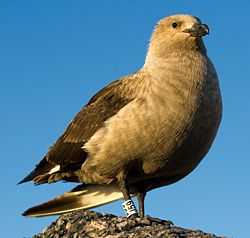
Aerial
- African harrier-hawk
- Antarctic skua
- Bald eagle
- Barred eagle owl
- Blakiston's fish owl
- Brown fish owl
- Cape eagle owl
- Crested eagle
- Crowned eagle
- Crowned hawk-eagle
- Eurasian eagle owl
- Forest eagle owl
- Giant petrel
- Golden eagle
- Goliath heron
- Great black-backed gull
- Great horned owl
- Great skua
- Harpy eagle
- Harris hawk
- Lappet-faced vulture
- Martial eagle
- New Guinea harpy eagle
- Osprey
- Pel's fish owl
- Philippine eagle
- Powerful owl
- Rock eagle owl
- Red tailed hawk
- Shelley's eagle owl
- South polar skua[1]
- Steller's sea eagle
- Tawny fish owl
- Verreaux's eagle owl
- Wedge-tailed eagle
- White-tailed eagle
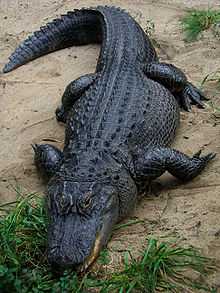
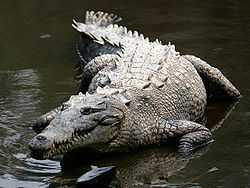
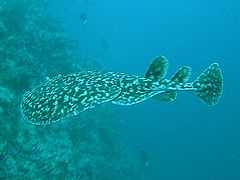
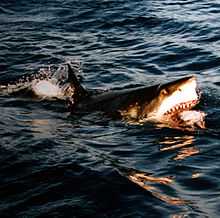

.jpg)
Aquatic
- African lungfish
- Alligator snapping turtle
- Alligator gar
- American alligator
- American crocodile
- Arapaima
- Atlantic goliath grouper
- Baiji (Chinese river dolphin)
- Baikal seal
- Beluga sturgeon
- Black caiman
- Black grouper
- Black marlin
- Atlantic blue marlin
- Blue whale
- Boto (Amazon river dolphin)
- Bowhead whale
- Bull shark
- Common snapping turtle
- Electric catfish
- Electric ray
- Esox lucius
- False gharial
- False killer whale
- Fin whale
- Gharial
- Giant freshwater stingray
- Giant grouper
- Giant otter
- Giant Pacific octopus
- Giant salamander
- Giant snakehead
- Giant trevally[2]
- Goonch catfish
- Goliath Tigerfish
- Great barracuda
- Greenland shark
- Great white shark
- Gray whale
- Humpback whale
- Kaluga (fish)
- Killer whale
- Lake trout[3]
- Largemouth bass
- Leatherback sea turtle
- Leopard seal[4]
- Lionfish
- Loggerhead sea turtle
- Marlin
- Mediterranean monk seal[5]
- Moray eel
- Murray cod
- Muskellunge
- Nassau grouper
- Nile crocodile
- Nile perch
- Northern pike
- North Atlantic right whale
- North Pacific right whale
- Piraíba
- Pseudoplatystoma (Surubí)
- Redtail catfish
- Salmon shark
- Saltwater crocodile
- Sailfish
- Stingray
- Sawfish
- South Asian river dolphin
- Semutundu catfish
- Smallmouth bass[3]
- Sperm whale
- Swordfish
- Syrinx aruanus
- Tiger shark
- Tigerfish
- Tuna
- Walleye
- Wels catfish
- White grouper
- White sturgeon
- Vundu
- Zungaro zungaro (Jau)
Notes: Animals with an asterisk (*) are only apex predators as introduced species.
References
- ↑ Bargagli, Roberto (2004). Antarctic Ecosystems. Springer. pp. 282–287. ISBN 3-540-22091-7.
- ↑ DeMartini, Edward E., Friedlander, Alan M., and Holzwarth, Stephani R. (2005). "Size at sex change in protogynous labroids, prey body size distributions, and apex predator densities at NW Hawaiian atolls". Marine ecology progress series 297: 259 -271. ISSN: 0171-8630. Retrieved on 2006-12-21.
- ↑ 3.0 3.1 Lepak, Jesse M., Kraft, Clifford E., and Weidel, Brian C. (2006). "Rapid Food Web Recovery in Response to Removal of an Introduced Apex Predator". Canadian Journal of Fisheries and Aquatic Sciences 63(3): 569-575. ISSN: 0706-652X. Retrieved on 2006-12-13.
- ↑ Kuhn, Carey E., McDonald, Birgitte I., Shaffer, Scott A., Barnes, Julie, Crocker, Daniel E., Burns, Jennifer, and Costa, Daniel P. (2006). "Diving physiology and winter foraging behavior of a juvenile leopard seal (Hydrurga leptonyx)". Polar Biology 29(4): 303-307. ISSN: 0722-4060. Retrieved on 2006-12-21.
- ↑ Levner, Eugene; Linkov, Igor; Proth, Jean-Marie (2005). Strategic Management of Marine Ecosystems. Springer. p. 41. ISBN 1-4020-3158-0.